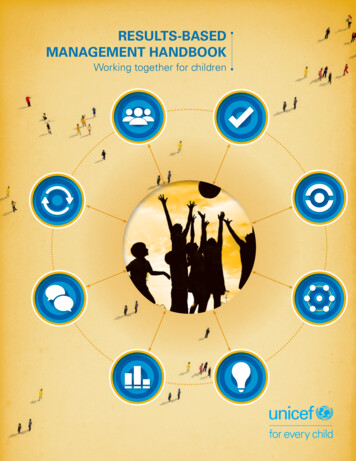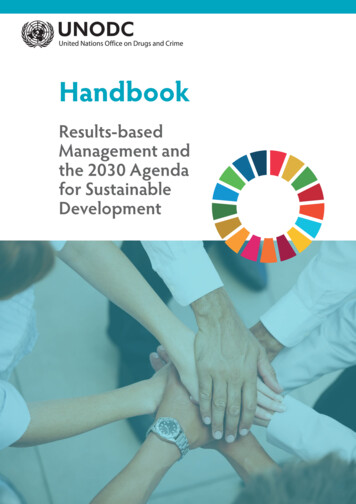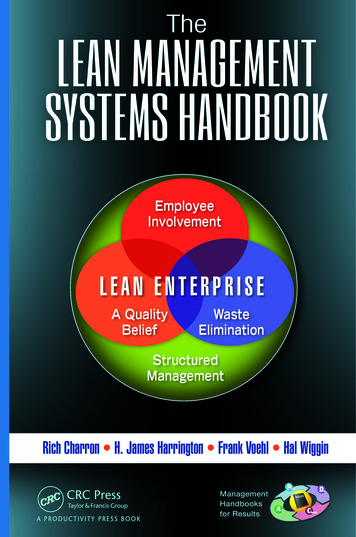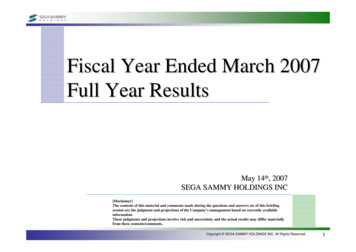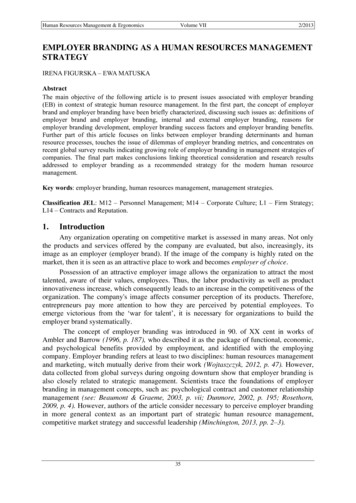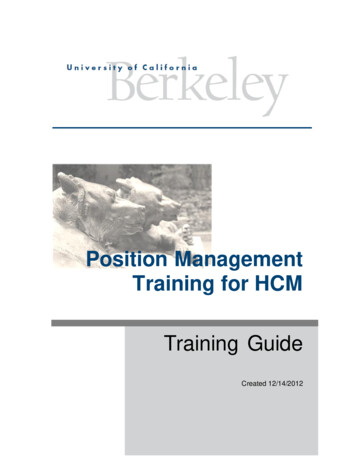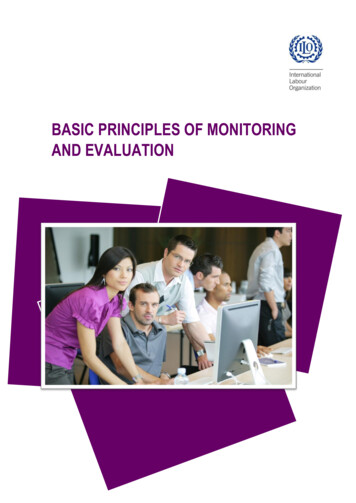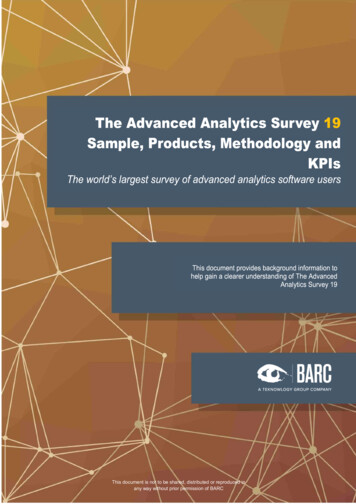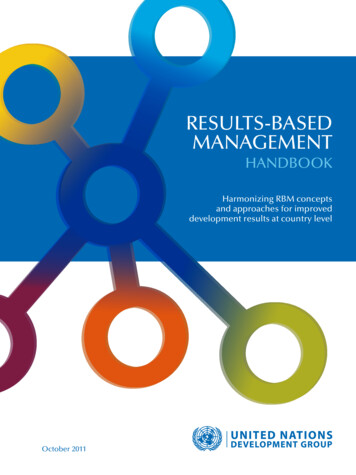
Transcription
RESULTS-BASEDMANAGEMENTHANDBOOKHarmonizing RBM conceptsand approaches for improveddevelopment results at country levelOctober 2011
ACKNOWLEDGEMENTSThis handbook development exercise was spearheaded by the Results-basedManagement (RBM) Task Team of the United Nations Development Groupworking group on programming issues. The team was co-chaired byUnited Nations Population Fund and the United Nations Children’s Fund andincluded the RBM focal points: United Nations Development Programme(Abdul Hannan, Shane Sheils, Patrick Tiefenbacher), UNICEF (Paulette Nichols,L.N. Balaji), UNFPA (Farah Usmani) the Joint United Nations Programme onHIV/AIDS - UNAIDS (Dominique Mathiot), the United Nations DevelopmentFund for Women (S.K.Guha), the Food and Agriculture Organization of theUnited Nations (Clare Sycamore), the United Nations World Food Programme(Kofi Owusu-Teiku) and the United Nations System Staff College (Ritsu NackenMorino). The team provided overall guidance, developed the scope and terms ofreference for the exercise, made specific review comments, provided backgrounddocumentation and references as well as drafted selected sections. The finalunedited draft of the handbook was endorsed by the RBM Task Team membersin October 2010.The draft of the RBM Handbook was prepared by Francoise Coupal, President,Mosaic International, Canada through a consultancy supported by the UnitedNations Development Operations Coordination Office (DOCO). Support fromDOCO (Eiko Narita, John Apruzzese) for the RBM handbook developmentexercise is recognized.The draft handbook was reviewed by field colleagues from selected ResidentCoordinator offices. These include Albania, Bosnia and Herzegovina, Cape Verde,Lao People’s Democratic Republic, Malawi, Pakistan, Papua New Guinea,Tanzania, Turkey, Uruguay and Viet Nam. These offices shared the handbook withRBM specialists in their United Nations Country Teams and provided commentsfrom a United Nations Development Assistance Framework and ‘Delivering asOne’ perspective which helped focus the handbook on field issues and needs.The United Nations Evaluation Group (UNEG) provided detailed commentsregarding RBM and evaluation linkages, including harmonization with UNEGnorms and standards. The draft handbook has also been shared with membersof the United Nations Strategic Planning Network. Review and comments onthe draft were also received from UNDAF Programming Network colleaguesincluding the United Nations Educational, Scientific and Cultural Organization,the International Labour Organization and the World Health Organization whichhave been addressed in this January 2011 revision.The Office for the Coordination of Humanitarian Affairs and DOCO coordinatedefforts to gather comments and input on the section on RBM in crisis and postcrisis settings through consultations with the UNDG Executive Committee onHumanitarian Assistance Working Group on Transitions. Thus, this handbook isalso envisaged to facilitate harmonization of RBM concepts and approaches incrisis and post-crisis situations.
United Nations Development GroupRESULTS-BASEDMANAGEMENTHANDBOOKHarmonizing RBM conceptsand approaches for improveddevelopment results at country levelOctober 2011Endorsed by the UNDG RBM task Team and incorporating comments fromUNDAF Programming Network review and UNDG meeting of January 2011
ACRONYMSCAPConsolidated Appeals ProcessCCACommon Country AssessmentCHAPCommon Humanitarian Action PlanCPAPCountry Programme Action PlanCPDCountry Programme DocumentCSOCivil society organizationDAC Development AssistanceCommittee of the (OECD)DARDevelopment assistance for refugeesDPKODepartment of Peacekeeping OperationsECOSOC United Nations Economic and Social CounciliiIMPPIntegrated Mission Planning ProcessISFIntegrated Strategic FrameworkJMACJoint Mission Analysis CentreMDGMillennium Development GoalM&EMonitoring and evaluationMfDRManaging for development resultsNGONon-governmental organizationPLAParticipatory Learning and ActionOECD Organisation for EconomicCo-operation and DevelopmentRRARapid rural appraisalRBMResults-based managementRC Resident Coordinator(of the United Nations system)SWApSector-wide approachesTCPR riennial comprehensive policy reviewTof operational activities for developmentUNCTUnited Nations Country TeamUNDAF United Nations DevelopmentAssistance FrameworkUNDGUnited Nations Development GroupUNEGUnited Nations Evaluation GroupWGPIWorking Group on Programming IssuesRESULTS-BASED MANAGEMENT HANDBOOK
TABLE OF CONTENTSINTRODUCTION ivPART 1: OVERVIEW OF RBM 11.1 What is Results-Based Management? 21.2 K ey Results-Based Management Principles: 3Accountability 3National Ownership of Results 4Inclusiveness (or Stakeholder Engagement) 5PART 7: USING RBM FOR LEARNING,ADJUSTING & DECISION-MAKING 43PART 8: RBM IN CRISIS ANDPOST-CRISIS SETTINGS 45Concerns in Crisis and Post-Crisis Settings 46ANNEXES 491.3 R esults-Based Management andManaging for Development Results 6Annex 1: Examples of UNDAF Results Matrices 1.4 Basic Results-Based Management Terminology 6Annex 2: Change Language 559BIBLIOGRAPHY PART 2: RBM IN PLANNING 2.1 What is a Result? 102.2 Getting Started: How to Define Results? 102.3 Formulating Results 122.4 The Results Chain 142.5 Developing the Results Matrix 152.5.1 Outcomes and Outputs 16 RBM: One of the Five United NationsProgramming Principles 172.5.2 Indicators, Baselines and Targets 192.5.3 Means of Verification 202.5.4 Assumptions and Risks 212.5.5 Role of Partners 222.5.6 Indicative Resources 22PART 3: RBM IN MANAGING 233.1 Managing for Outcomes 5056FIGURES, BOXES AND TABLESFigures1. The RBM Life-Cycle Approach 22. Accountability 43. Key Stages in Formulating Results Statements 104. Elements of an Effective Results-Based Report 415. Use of Results Information forOrganizational Learning 44Boxes1. Six Principles for United NationsOrganizations to Contribute Effectivelyto Results-Based Management 52. Definition of Key United NationsProgramming Terms 7243. What does a Human-Rights-BasedApproach add to RBM? 183.2 Managing for UNDAF Outcomes 244. What is Evaluation? 34PART 4: RBM IN MONITORING 275. Assessing the use of an Evaluation 354.1 Tools for Monitoring 284.2 D eveloping the Monitoring andEvaluation Plan 306. Understanding the Inter-Linkages anddependencies between Planning,Monitoring and Evaluation 374.3 M onitoring and Evaluation of theUNDAF as a System 31Tables1. Changes reflected in Results at different Levels 134.4 M easuring Progress in Policy Normsand Standards 2. The Results Chain 1432PART 5: RBM IN EVALUATION 335.1 Results-Based Management in Evaluation 345.2 United Nations Evaluation Guidance 363. Results Matrix with Outcomeand Output Levels – Option 1B 164. Indicators 195. Checklist for Validating Indicators 206. Risk Matrix 225.3 I nter-Linkages and dependencies betweenPlanning, Monitoring and Evaluation 377. Key Challenges and Strategies to Overcome them 24PART 6: RBM IN REPORTING 398. M&E Calendar 329. Example of a Results-Based Report 42Table of Contentsiii
INTRODUCTIONIn the late 1990s, the United Nations initiated results-basedmanagement (RBM) systems1 to improve the organization’s2effectiveness and accountability. A 2008 review of the status of RBMimplementation in the United Nations system showed that different RBM definitions and terminology were in use among United Nations organizations. Moreimportantly, these variations reflected a disparity in focus, understanding andperception of RBM within the system.3The differences made it difficult tocommunicate on RBM issues using acommon language. It is recognized thatthere is no single ‘road map’ to RBM andthat each organization must adapt RBMto its specificities and mandates in thecontext of national priorities. Yet, there arealso a wide range of commonalities amongUnited Nations organizations that constitutea basis for harmonizing implementation ofRBM system-wide.Harmonization is particularly importantin the context of United Nations reformwith its emphasis on harmonized supportto development activities at county levelincluding joint initiatives/joint programming. In resolution 62/208 regarding thetriennial comprehensive policy review(TCPR), the General Assembly stressed1234ivthat, “The purpose of reform is to makethe United Nations development systemmore efficient and effective in its support todeveloping countries to achieve the internationally agreed development goals, on thebasis of their national development strategies, and stresses also that reform effortsshould enhance organizational efficiencyand achieve concrete development results.”4United Nations system’s value addition atcountry level to the national strategies andpriorities is by support to achieving andsustaining national development resultsthrough its normative role and mandatebased on the United Nations charter. Thecommitment of the United Nations system toachieve results in full alignment with nationalpriorities is part and parcel of its shared identity and an important aspect of its legitimacy.See JIU/REP/2004/6, Implementation of RBM in UN Organizations Part 1.Reference to United Nations agencies, organizations and system in this document includes all United Nations funds, programmesand specialized agencies, unless stated otherwise.Results Based Management at country level: Systemic issues that prevent good UNDAF results and the use of UNDAF resultsinformation, Alex Mackenzie, 2008.TCPR resolution A/RES/62/208, paragraph 9. See also paragraph 33, which stresses, “results-based management, accountability andtransparency of the United Nations development system are an integral part of sound management.”RESULTS-BASED MANAGEMENT HANDBOOK
This RBM Handbook was developed underthe United Nations Development Group(UNDG) Working Group on ProgrammingIssues (WGPI) in the context of GeneralAssembly resolution 62/208 (and itsdirectives in paragraph 100) to facilitateconsistency and harmonization throughcommonly agreed results-based programme5management concepts and approaches inthe United Nations system.PURPOSE OF THE HANDBOOKThe main purpose of the Handbook isto provide United Nationsfunds, programmes andspecialized agencieswith common groundfor supporting nationalprogramme planning,implementation monitoring and reporting based on best practices inthe RBM field. The Handbook responds tothe evolving dynamics of RBM in line withTCPR commitments while taking note ofdevelopments within the Organisation forEconomic Co-operation and Development/Development Assistance Committee (OECD/DAC), such as the Paris Declaration and theAccra Agenda for Action.Toward this objective, the Handbook isexpected to:5 contribute to harmonizing United Nationsbusiness practices around ‘contributingto national efforts for achievingdevelopment results’; provide a common framework for interagency collaboration to support countriesin programme design, implementation andmanaging for development results, including monitoring, evaluation and reporting; Increase the quality and effectiveness ofUnited Nations-supported interventionsfor achieving sustained results.The Handbook is intended to besuccinct, user-friendly and explainconcepts and tools in ways thatwill facilitate operationalizingharmonized RBM approaches. Itprovides a common denominator forthe use of RBM by all United Nations staffmembers and stakeholders, particularlywhen developing and implementing theirUnited Nations Development AssistanceFramework (UNDAF). Key concepts, principles and terminology are presented alongwith different frameworks, such as a resultsmatrix, a risk mitigation framework and aresults-based reporting framework.It is not meant to be an exhaustive ‘howto’ manual. Web links and references areincluded to resources and tools that providegreater detail.The focus of this handbook is primarily on RBM in the programme elements. However, the concepts and definitions are alsoapplicable to management aspects. Other UNDG working groups are focusing on financial management and RBM and links withthese are provided in the document.Introductionv
INTRODUCTION (cont’d)AUDIENCE OF THE HANDBOOKThe Handbook is addressed to allUnited Nations staff at country, regionaland headquarters levels, especiallythose responsible for RBM planning, implementation, monitoringand evaluation (M&E), managingand reporting. National authorities at various levels (central, local)may also find the Handbook usefulas it introduces key RBM concepts, toolsand instruments used by the United Nationssystem in development as well as crisis,transition and post crisis situations. Othernational actors, including international andnational non-governmental organizations(NGOs), and parties responsible for variouselements of programming at country levelfor achieving developmental results wouldalso find the handbook useful.ORGANIZATION OF THE HANDBOOKThe RBM Handbook is arranged primarilyaround the programme cycle. Readersmay also refer to UNDG guidance on theCommon Budgetary Framework and otherbusiness operations.Part one provides an overview of RBM,explaining the importance of accountability, national ownership and inclusivenessas a backdrop for undertaking effectiveRBM. This is discussed in the context ofviRESULTS-BASED MANAGEMENT HANDBOOKthe rapidly changing aid environment withnationally owned and driven results, withthe United Nations viewed predominantly as a contributor to achievingnational results.Part two examines RBM in theplanning stages. It presents variousplanning tools, such as the resultsmatrix, the M&E plan, and the riskmitigation strategy framework. Part threeexplores the importance of the managementfunction of RBM, focusing on managingfor results.Part four presents monitoring as anessential component for assessing resultson an on-going basis. Part five presentsevaluation and its role in assessing overallperformance, while part six encourages thereader to more effectively report on resultsby focusing particularly on outputs andoutcomes rather than activities.Finally, part seven discusses how to useRBM for learning, adjusting and decisionmaking. An additional section, part eight,which has been included based on fieldneeds and reviews, highlights critical RBMissues in crisis and post-crisis situations aswell as underlining the need for adoption ofcommon RBM approaches and terminologyin these settings.
PART 1: OVERVIEW OF RBMPART 1OVERVIEW OF RBM1.1. What is Results-Based Management?. 21.2. Key Results-Based Management Principles. 31.3. RBM and Managing for Development Results. 61.4. Basic RBM Terminology. 6PART 1: Overview of RBM1
OVERVIEW OF RESULTS-BASED MANAGEMENT1.1 WHAT IS RESULTS-BASED MANAGEMENT?RBM is a management strategy by which all actors, contributing directly or indirectly toachieving a set of results, ensure that their processes, products and services contribute tothe achievement of desired results (outputs, outcomes and higher level goals or impact).The actors in turn use information and evidence on actual results to inform decisionmaking on the design, resourcing and delivery of programmes and activities as well asfor accountability and reporting.RBM is seen as taking a life-cycle approach(see Figure 1). It starts with elements of planning,such as setting the vision and defining the resultsframework. Once partners agree to pursue a setof results through a programme, implementationstarts and monitoring becomes an essential task toensure results are being achieved. M&E provideinvaluable information for decision-making andlessons learned for the future.PNTINManagingand and usingmonitoringMODefining theresults mapand RBMframeworkPlanning formonitoringand evaluationNITORINGSource: UNDP, Handbook on Planning, Monitoring and Evaluating for Development Results, 2009.2RESULTS-BASED MANAGEMENT HANDBOOKNGUASettingthe visionNIE VA LLAOFIGURE 1: The RBM life-cycle approach
11.2 KEY RESULTS-BASEDMANAGEMENT PRINCIPLESTHREE KEY PRINCIPLES of RBM are: Accountability National Ownership InclusivenessACCOUNTABILITYTCPR resolutions have long stressed the need forUnited Nations development entities to achieveand uphold the highest levels of accountabilitywhen supporting partner countries in pursuing national development outcomes.6 Morerecently, a high level symposium of the UnitedNations Economic and Social Council (ECOSOC)Development Cooperation Forum discussedactions to improve mutual accountability atglobal, regional and national levels, as well asits forms and processes.7 In addition, the ParisDeclaration indicators and related targets includeaccountability expectations from both nationalgovernments and donors.The concept of mutual accountability hasbecome established as criteria for developmentand aid effectiveness, although questions remainaround actual implications. For the purpose ofthe UNDAF, mutual accountability is interpretedto mean the respective accountability of partiesworking together toward shared outcomes.This notion of respective accountability reflectsthe fact that accountability is not fungible andmust, in the final analysis, be attached to aspecific actor. Many stakeholders contribute to678UNDAF outcomes and each one ofthem is accountable for its contribution.Below are accountability expectations ofthe various stakeholders at different levelsof engagement in the context of a sequenceof desired results at the national level.8Governments: Governments are the primaryowner and executing agents of cooperationprogrammes and are accountable to theirpeople, through their parliaments, for deliveringon national development objectives (sometimes referred to as national goals, prioritiesor outcomes). Results that occur at this levelare primarily attributable to the government,although this may sometimes differ dependingon the national context.United Nations Country Team (UNCT):United Nations funds, programmes andspecialized agencies as members of the UNCTcollaborate with national counterparts to determine the outcomes of the United Nations supportin a particular country. The outcomes of UnitedNations support are framed in the UNDAF or otheragreed common document and always derive fromthe country’s national development objectives.UNCT members are accountable to the nationalpartners on the basis of the Basic CooperationAgreement between the United Nations and thehost country on the one hand, and to partnergovernments funding development activities in thecountry through the United Nations, on the other.Individual United Nations funds, programmesand specialized agencies: At the nationallevel, each of these United Nations entities areSee, for instance, GA resolution 62/208, paragraph 61, which calls on “the organizations of the United Nations development system, within theirorganizational mandates, to further improve their institutional accountability mechanisms.” Paragraph 113 further calls “to continue to harmonizeand simplify their rules and procedures, wherever this can lead to a significant reduction in the administrative and procedural burden on the organizations and national partners, bearing in mind the special circumstances of programme countries, and to enhance the efficiency, accountabilityand transparency of the United Nations development system.”Enhancing Mutual Accountability and Transparency in Development Cooperation, ECOSOC. November 2009A more macro perspective of accountability is provided in the UNDG Management and Accountability System.PART 1: Overview of RBM3
accountable for their specific agreed contributionto the selected UNDAF outcomes as per theiragency mandate and comparative advantagein the country. At the same time, each entity isaccountable to its own governing body. Upwardreporting to governing bodies does not focus onnational development performance. Instead, itfocuses on the contributions made by individualUnited Nations agencies to UNDAF results andthe influence of these on the national development objectives. The accountability for resultsof UNCT members to their respective governingbodies is limited to the level at which results canbe attributed to the UNCT.Implementation partners: Various partnersincluding local authorities and civil societyorganizations have an implementation role andthus have mutual accountability for the deliveryof goods and services to the national authoritiesand the local communities. Typically, the implementing partners are the key to achievement ofoutputs and activities.Providers of inputs: Finally, providers of inputs,such as vendors and contractors, are accountable to implementing partners for the satisfactorydelivery of specified items.Figure 2 delineates individual accountabilitywithin an overall flow of activity leading towardhigher-level outcomes, with accountabilityestablished at each level. UNCTs may wish toconsider using the figure as a way to clarifyaccountabilities within their UNDAFs. At eachlevel, there is an expectation that an accountableparty has the capacity to undertake its responsibilities to make its contributions to the results. Ifthis capacity is not in place, then either capacity needs to be developed or, where applicable,alternative arrangements sought.NATIONAL OWNERSHIP OF RESULTSAs stated in the TCPR 62/208, “each countrymust take primary responsibility for its owndevelopment and the role of national policiesand development strategies cannot be overemphasized in the achievement of sustainableFIGURE 2: AccountabilityNational Governments are accountable to their people, through their parliaments,for delivering on national development objectives.UNCTs are accountable to governments for overall contribution tonational development objectives, through their contribution to theachievement of specific UNDAF-level outcomes.Each UN Agency is accountable for its contribution to selected UNDAF outcomes as per their agency mandate and its agreed country programme,including to national authorities as well as to its governing board.For the purposeof the UNDAF,mutual accountabilityis interpreted to mean therespective accountabilityof parties working togethertoward shared outcomes.4Implementing partners including local authoritiesand civil society organizations have mutualaccountability for the achievement of outputsand activities to the national authoritiesand the communities themselves.Providers of inputs areaccountable to implementing partners for thesatisfactory deliveryof specifieditems.RESULTS-BASED MANAGEMENT HANDBOOK
1BOX1SIX PRINCIPLES FOR UNITED NATIONS ORGANIZATIONS TOCONTRIBUTE EFFECTIVELY TO RESULTS-BASED MANAGEMENT1) Foster senior-levelleadership in RBM inall organizations, withnational actors playinga major lead;2) Promote and supporta results culture byall actors, includingnational, sub-nationaland local governments,civil society organizations, communities,United Nations agenciesand partner governments.In particular support:- an informed demand forresults information;- supportive country/national systems,procedures andincentives;- a results-orientedaccountability regime;- fostering learningand adjusting;- clear roles and responsibilities for RBM.3) Build results frameworkswith clearly defined ownership on the part of nationalactors at all levels, andwith the contribution androles of the United Nationsclearly agreed upon;development”. To maximize national ownershipand sovereignty, programmes and projects ofthe United Nations must be based on nationalpriorities, strategies and local needs. They areenvisaged to complement national efforts. Impactand higher level results are then predominantlyowned by national actors with the UnitedNations contributing to these results. However,national ownership does not mean that theUnited Nations is not accountable.A key aim of RBM is to ensure that nationalownership goes beyond a few select persons toinclude as many diverse stakeholders as possible.For this reason, M&E activities and the findings,recommendations and lessons learned should befully owned by those responsible for the results4) Measure sensibly anddevelop user-friendlyRBM information systems;5) Use results informationfor learning and managing,as well as for reportingand accountability;6) Build an adaptive RBMregime through regularreview and updating offrameworks.Source: John Mayne, Best Practices inResults Based Management: A Reviewof Experience, July 2007, p.4.and those who can make use of them. Moredetailed information on the concept of nationalownership in relation to common countryprogramming and aid effectiveness is availableon the UNDG website.INCLUSIVENESS (or stakeholder engagement)Finally, inclusiveness is another important RBMprinciple. A strong RBM process aims to engagestakeholders (including government institutionsat national, sub-national and local levels, as wellas civil society organizations and communitiesthemselves) in thinking as openly and creativelyas possible about what they want to achievewhile encouraging them to organize themselves to achieve what they have agreed upon,including establishing a process to monitor andPART 1: Overview of RBM5
evaluate progress and use the information toimprove performance. Engagement of all relevantstakeholders in all stages of the programmingprocess maximizes the contribution that theUnited Nations system can make, through theUNDAF, to the national development process.An MfDR approach encourages developmentagencies to focus on building partnerships andcollaboration and ensure greater coherence.Similarly, it promotes stronger focus on sustainability through measures that enhance nationalownership and capacity development.Increasing evidence shows that sustainability ismore likely when rights-holders are involved inpeace-building or development processes fromthe outset – including during country analysis,defining results and indicators, implementation,and M&E of programmes and projects. Onecannot expect rights-holders to be responsiblefor results and indicators they do not help define,negotiate or agree upon. Stakeholder analysisshould consider the mandate and interest ofvarious partners.RBM approaches have traditionally focusedmore on internal results and performance ofagencies rather than on changes in the development conditions of people. In RBM, like MfDR,‘results’ are understood to go beyond management (systems, scorecards, metrics, reporting)and should be dynamic and transformative sothat results inform decision-making and lead tocontinuous improvement and change. In thisHandbook, the term ‘results-based management’is used to cover both: (i) the results from development assistance; and (ii) an agency’s internalperformance and results.91.3 RESULTS-BASED MANAGEMENTAND MANAGING FORDEVELOPMENT RESULTSManaging for development results (MfDR)applies the same basic concepts as RBM (planning, monitoring, evaluating and learning) butseeks to keep the focus on development assistance demonstrating real and meaningful results.MfDR is oriented more toward the externalenvironment and results that are important toprogramme countries and less toward an agency’sinternal performance.MfDR is an effort to respond to the growingdemand for public accountability in both thedeveloped and developing worlds on howassistance is used, what results are achieved andhow appropriate these results are in bringingabout desired changes in human development.91061.4 BASIC RESULTS-BASEDMANAGEMENT TERMINOLOGYIt is recognized that many United Nationsagencies are using different RBM definitions andterminologies, even though the concepts are,in many cases, analogous. The use of commonterminology will help United Nations agenciesmove toward a common ground for supportingnational programming (see Box 2).When adopted across the board by UnitedNations agencies, these definitions can contributeto greater coherence and consistency and helpwhen communicating RBM issues with nationalgovernments. The basic terminology used in thishandbook is taken from several sources and isstrengthened by best practices in the RBM field.10More detailed information and resources on MfDR are available on the MfDR website.OECD/DAC Glossary of Key Terms in Evaluation and Results-based Management; UNDG Results-based Management Terminology 2003.www.undg.org/rbmRESULTS-BASED MANAGEMENT HANDBOOK
1BOX2DEFINITION OF KEY UNITED NATIONS PROGRAMMING TERMSResults basedmanagement (RBM)Results-based managementis a management strategyby which all actors, contributing directly or indirectlyto achieving a set of results,ensure that their processes,products and services contribute to the desired results(outputs, outcomes andhigher level goals or impact)and use information andevidence on actual resultsto inform decision makingon the design, resourcingand delivery of programmesand activities as well as foraccountability and reporting.ResultsResults are changes in a stateor condition that derive froma cause-and-effect relationship. There are three typesof such changes - outputs,outcomes and impact - thatcan be set in motion by adevelopment intervention.The changes can be intendedor unintended, positive and/or negative.Results chainThe causal sequence for adevelopment interventionthat stipulates the necessary sequence to achievedesired results – beginningwith inputs, moving throughactivities and outputs, andculminating in individualoutcomes and those thatinfluence outcomes for thecommunity, goal/impacts andfeedback. It is based on atheory of change, includingunderlying assumptions.ImpactImpact implies changes inpeople’s lives. This mightinclude changes in knowledge, skill, behaviour, healthor living conditions forchildren, adults, families orcommunities. Such changesare positive or negative longterm effects on identifiablepopulation groups producedby a development intervention, directly or indirectly,intended or unintended. Theseeff
he focus of this handbook is primarily on RBM in the programme elements. However, the concepts and definitions are also T applicable to management aspects. Other UNDG working groups are focusing on financial management and RBM and links with these are provided in the document. This RBM Handbook
